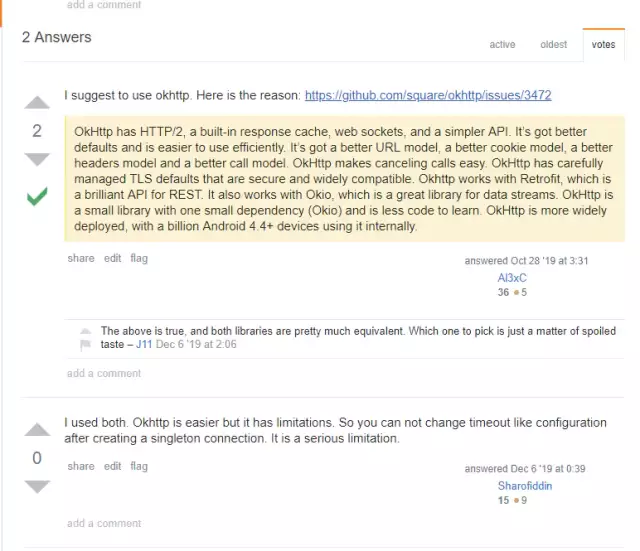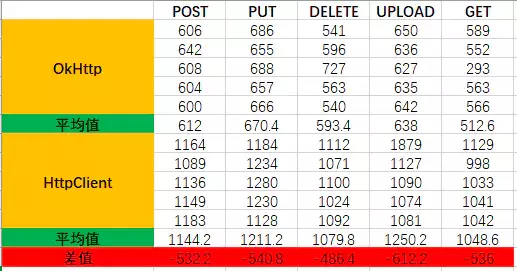1、有关于HttpClient和OkHttp两种调用服务的方式区别,我们先到overstackflow上看看大牛们的讨论。

所以从使用、性能、超时配置方面进行比较
使用
HttpClient和OkHttp一般用于调用其它服务,一般服务暴露出来的接口都为http,http常用请求类型就为GET、PUT、POST和DELETE,因此主要介绍这些请求类型的调用。
HttpClient使用介绍
使用HttpClient发送请求主要分为以下几步骤:
-
创建 CloseableHttpClient对象或CloseableHttpAsyncClient对象,前者同步,后者为异步
-
创建Http请求对象
-
调用execute方法执行请求,如果是异步请求在执行之前需调用start方法
创建连接:
CloseableHttpClient httpClient = HttpClientBuilder.create().build();
该连接为同步连接
GET请求:
1 @Test 2 public void testGet() throws IOException { 3 String api = "/api/files/1"; 4 String url = String.format("%s%s", BASE_URL, api); 5 HttpGet httpGet = new HttpGet(url); 6 CloseableHttpResponse response = httpClient.execute(httpGet); 7 System.out.println(EntityUtils.toString(response.getEntity())); 8 }
使用HttpGet表示该连接为GET请求,HttpClient调用execute方法发送GET请求
PUT请求:
1 @Test 2 public void testPut() throws IOException { 3 String api = "/api/user"; 4 String url = String.format("%s%s", BASE_URL, api); 5 HttpPut httpPut = new HttpPut(url); 6 UserVO userVO = UserVO.builder().name("h2t").id(16L).build(); 7 httpPut.setHeader("Content-Type", "application/json;charset=utf8"); 8 httpPut.setEntity(new StringEntity(JSONObject.toJSONString(userVO), "UTF-8")); 9 CloseableHttpResponse response = httpClient.execute(httpPut); 10 System.out.println(EntityUtils.toString(response.getEntity())); 11 }
POST请求:
添加对象
1 @Test 2 public void testPost() throws IOException { 3 String api = "/api/user"; 4 String url = String.format("%s%s", BASE_URL, api); 5 HttpPost httpPost = new HttpPost(url); 6 UserVO userVO = UserVO.builder().name("h2t2").build(); 7 httpPost.setHeader("Content-Type", "application/json;charset=utf8"); 8 httpPost.setEntity(new StringEntity(JSONObject.toJSONString(userVO), "UTF-8")); 9 CloseableHttpResponse response = httpClient.execute(httpPost); 10 System.out.println(EntityUtils.toString(response.getEntity())); 11 }
该请求是一个创建对象的请求,需要传入一个json字符串
上传文件
1 @Test 2 public void testUpload1() throws IOException { 3 String api = "/api/files/1"; 4 String url = String.format("%s%s", BASE_URL, api); 5 HttpPost httpPost = new HttpPost(url); 6 File file = new File("C:/Users/hetiantian/Desktop/学习/docker_practice.pdf"); 7 FileBody fileBody = new FileBody(file); 8 MultipartEntityBuilder builder = MultipartEntityBuilder.create(); 9 builder.setMode(HttpMultipartMode.BROWSER_COMPATIBLE); 10 builder.addPart("file", fileBody); //addPart上传文件 11 HttpEntity entity = builder.build(); 12 httpPost.setEntity(entity); 13 CloseableHttpResponse response = httpClient.execute(httpPost); 14 System.out.println(EntityUtils.toString(response.getEntity())); 15 }
通过addPart上传文件
DELETE请求:
1 @Test 2 public void testDelete() throws IOException { 3 String api = "/api/user/12"; 4 String url = String.format("%s%s", BASE_URL, api); 5 HttpDelete httpDelete = new HttpDelete(url); 6 CloseableHttpResponse response = httpClient.execute(httpDelete); 7 System.out.println(EntityUtils.toString(response.getEntity())); 8 }
请求的取消:
1 @Test 2 public void testCancel() throws IOException { 3 String api = "/api/files/1"; 4 String url = String.format("%s%s", BASE_URL, api); 5 HttpGet httpGet = new HttpGet(url); 6 httpGet.setConfig(requestConfig); //设置超时时间 7 //测试连接的取消 8 9 long begin = System.currentTimeMillis(); 10 CloseableHttpResponse response = httpClient.execute(httpGet); 11 while (true) { 12 if (System.currentTimeMillis() - begin > 1000) { 13 httpGet.abort(); 14 System.out.println("task canceled"); 15 break; 16 } 17 } 18 19 System.out.println(EntityUtils.toString(response.getEntity())); 20 }
调用abort方法取消请求 执行结果:
1 task canceled 2 cost 8098 msc 3 Disconnected from the target VM, address: '127.0.0.1:60549', transport: 'socket' 4 5 java.net.SocketException: socket closed...【省略】
OkHttp使用
使用OkHttp发送请求主要分为以下几步骤:
-
创建OkHttpClient对象
-
创建Request对象
-
将Request 对象封装为Call
-
通过Call 来执行同步或异步请求,调用execute方法同步执行,调用enqueue方法异步执行
创建连接:
private OkHttpClient client = new OkHttpClient();
GET请求:
1 @Test 2 public void testGet() throws IOException { 3 String api = "/api/files/1"; 4 String url = String.format("%s%s", BASE_URL, api); 5 Request request = new Request.Builder() 6 .url(url) 7 .get() 8 .build(); 9 final Call call = client.newCall(request); 10 Response response = call.execute(); 11 System.out.println(response.body().string()); 12 }
PUT请求:
1 @Test 2 public void testPut() throws IOException { 3 String api = "/api/user"; 4 String url = String.format("%s%s", BASE_URL, api); 5 //请求参数 6 UserVO userVO = UserVO.builder().name("h2t").id(11L).build(); 7 RequestBody requestBody = RequestBody.create(MediaType.parse("application/json; charset=utf-8"), 8 JSONObject.toJSONString(userVO)); 9 Request request = new Request.Builder() 10 .url(url) 11 .put(requestBody) 12 .build(); 13 final Call call = client.newCall(request); 14 Response response = call.execute(); 15 System.out.println(response.body().string()); 16 }
POST请求:
添加对象
1 @Test 2 public void testPost() throws IOException { 3 String api = "/api/user"; 4 String url = String.format("%s%s", BASE_URL, api); 5 //请求参数 6 JSONObject json = new JSONObject(); 7 json.put("name", "hetiantian"); 8 RequestBody requestBody = RequestBody.create(MediaType.parse("application/json; charset=utf-8"), String.valueOf(json)); 9 Request request = new Request.Builder() 10 .url(url) 11 .post(requestBody) //post请求 12 .build(); 13 final Call call = client.newCall(request); 14 Response response = call.execute(); 15 System.out.println(response.body().string()); 16 }
上传文件
1 @Test 2 public void testUpload() throws IOException { 3 String api = "/api/files/1"; 4 String url = String.format("%s%s", BASE_URL, api); 5 RequestBody requestBody = new MultipartBody.Builder() 6 .setType(MultipartBody.FORM) 7 .addFormDataPart("file", "docker_practice.pdf", 8 RequestBody.create(MediaType.parse("multipart/form-data"), 9 new File("C:/Users/hetiantian/Desktop/学习/docker_practice.pdf"))) 10 .build(); 11 Request request = new Request.Builder() 12 .url(url) 13 .post(requestBody) //默认为GET请求,可以不写 14 .build(); 15 final Call call = client.newCall(request); 16 Response response = call.execute(); 17 System.out.println(response.body().string()); 18 }
通过addFormDataPart方法模拟表单方式上传文件DELETE请求:
1 @Test 2 public void testDelete() throws IOException { 3 String url = String.format("%s%s", BASE_URL, api); 4 //请求参数 5 Request request = new Request.Builder() 6 .url(url) 7 .delete() 8 .build(); 9 final Call call = client.newCall(request); 10 Response response = call.execute(); 11 System.out.println(response.body().string()); 12 }
请求的取消:
1 @Test 2 public void testCancelSysnc() throws IOException { 3 String api = "/api/files/1"; 4 String url = String.format("%s%s", BASE_URL, api); 5 Request request = new Request.Builder() 6 .url(url) 7 .get() 8 .build(); 9 final Call call = client.newCall(request); 10 Response response = call.execute(); 11 long start = System.currentTimeMillis(); 12 //测试连接的取消 13 while (true) { 14 //1分钟获取不到结果就取消请求 15 if (System.currentTimeMillis() - start > 1000) { 16 call.cancel(); 17 System.out.println("task canceled"); 18 break; 19 } 20 } 21 22 System.out.println(response.body().string()); 23 }
调用cancel方法进行取消 测试结果:
1 task canceled 2 cost 9110 msc 3 4 java.net.SocketException: socket closed...【省略】
小结
OkHttp使用build模式创建对象来的更简洁一些,并且使用.post/.delete/.put/.get方法表示请求类型,不需要像HttpClient创建HttpGet、HttpPost等这些方法来创建请求类型
依赖包上,如果HttpClient需要发送异步请求、实现文件上传,需要额外的引入异步请求依赖
1 <!---文件上传--> 2 <dependency> 3 <groupId>org.apache.httpcomponents</groupId> 4 <artifactId>httpmime</artifactId> 5 <version>4.5.3</version> 6 </dependency> 7 <!--异步请求--> 8 <dependency> 9 <groupId>org.apache.httpcomponents</groupId> 10 <artifactId>httpasyncclient</artifactId> 11 <version>4.5.3</version> 12 </dependency>
请求的取消,HttpClient使用abort方法,OkHttp使用cancel方法,都挺简单的,如果使用的是异步client,则在抛出异常时调用取消请求的方法即可
超时设置
HttpClient超时设置:
在HttpClient4.3+版本以上,超时设置通过RequestConfig进行设置
1 private CloseableHttpClient httpClient = HttpClientBuilder.create().build(); 2 private RequestConfig requestConfig = RequestConfig.custom() 3 .setSocketTimeout(60 * 1000) 4 .setConnectTimeout(60 * 1000).build(); 5 String api = "/api/files/1"; 6 String url = String.format("%s%s", BASE_URL, api); 7 HttpGet httpGet = new HttpGet(url); 8 httpGet.setConfig(requestConfig); //设置超时时间
超时时间是设置在请求类型HttpGet上,而不是HttpClient上
OkHttp超时设置:
直接在OkHttp上进行设置
1 private OkHttpClient client = new OkHttpClient.Builder() 2 .connectTimeout(60, TimeUnit.SECONDS)//设置连接超时时间 3 .readTimeout(60, TimeUnit.SECONDS)//设置读取超时时间 4 .build();
小结:
如果client是单例模式,HttpClient在设置超时方面来的更灵活,针对不同请求类型设置不同的超时时间,OkHttp一旦设置了超时时间,所有请求类型的超时时间也就确定
HttpClient和OkHttp性能比较
测试环境:
-
CPU 六核
-
内存 8G
-
windows10
每种测试用例都测试五次,排除偶然性
client连接为单例:

client连接不为单例:

单例模式下,HttpClient的响应速度要更快一些,单位为毫秒,性能差异相差不大
非单例模式下,OkHttp的性能更好,HttpClient创建连接比较耗时,因为多数情况下这些资源都会写成单例模式,因此图一的测试结果更具有参考价值
总结
OkHttp和HttpClient在性能和使用上不分伯仲,根据实际业务选择即可